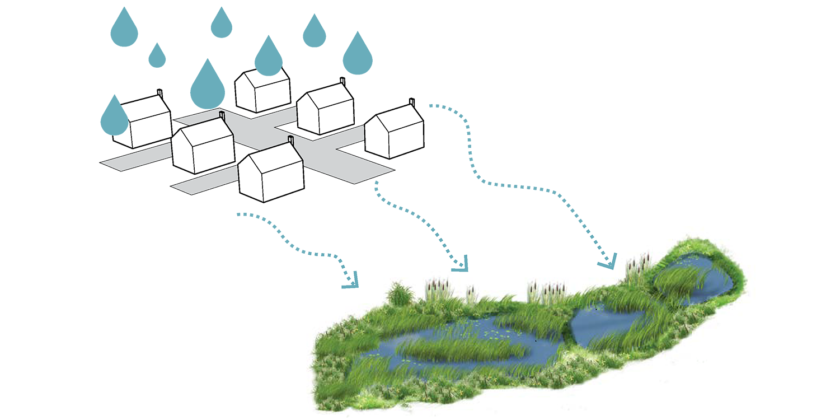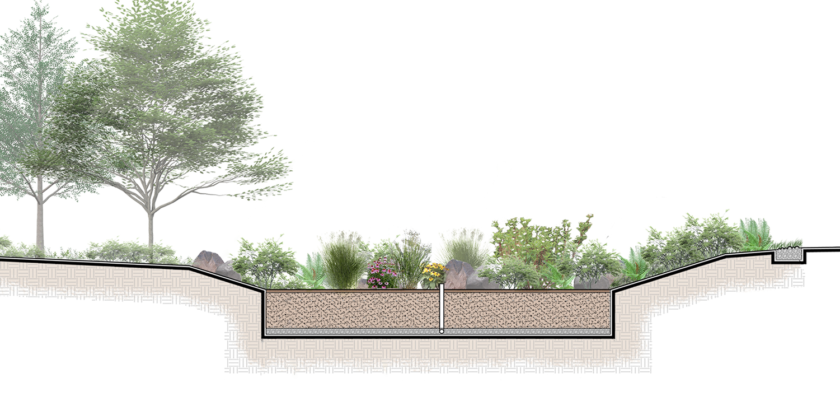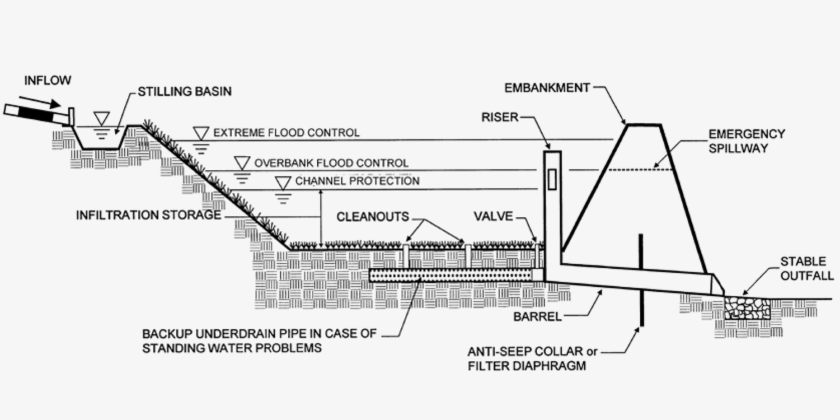Protecting & Restoring Long Island's Peconic Bays

The surface runoff category includes best management practices (BMPs) that capture stormwater and remove nitrogen through non-structural BMPs including wet ponds, wetlands, and structural BMPs such as rain gardens and infiltration basins. These practices not only support management of stormwater quantity but may be selected and designed to improve stormwater quality and reduce nitrogen levels in the most cost-effective manner (NYS 2015). Stormwater BMP costs are annualized and presented on a per acre treated basis by multiplying by the impervious cover of the drainage area they are treating, to enable comparison of BMPs with different lifespans, treatment area, and removal effectiveness (Wossink and Hunt 2003).

View more information on Wetlands and Wet Ponds >>

View more information in Rain Gardens >>

View more information in Infiltration Basins >>
Barr Engineering Company, 2011. Best Management Practices Construction Costs, Maintenance Costs, and Land Requirements.
Brown, R.A. and W.F. Hunt, 2011. “Impacts of Media Depth on Effluent Water Quality and Hydrologic Performance of Undersized Bioretention Cells.” Journal of Irrigation and Drainage Engineering 137(3):132–143.
Charles River Watershed Association, 2010. Stormwater Management Plan for Spruce Pond Brook Subwatershed. August, 2010.
Chesapeake Bay Program, 2018. Chesapeake Bay Program Quick Reference Guide for Best Management Practices (BMPs): Nonpoint Source BMPs to Reduce Nitrogen, Phosphorus and Sediment Loads to the Chesapeake Bay and its Local Waters. CBP/TRS-323-18. Available at: https://www.dec.ny.gov/docs/water_pdf/cbbmpguide18.pdf.
Chesapeake Bay Program, 2020. “Chesapeake Assessment and Scenario Tool (CAST) Version 2019.” Chesapeake Bay Program Office. Accessed May 2021. Available at: https://cast.chesapeakebay.net/.
Claytor, R.A. and T.R. Schueler, 1996. Design of Stormwater Filtering Systems. Report prepared for Chesapeake Research Consortium, Inc. December 1996.
CWP (Center for Watershed Protection), 2007. Urban Stormwater Retrofit Practices Version 1.0. Prepared for Office of Wastewater Management U.S. Environmental Protection Agency. July, 2007.
DeBusk, K.M. and T.M. Wynn, 2011. “Stormwater Bioretention for Runoff Quality and Quality Mitigation.” Journal of Environmental Engineering 137(9):800–808.
Dietz, M.E. and J.C. Clausen, 2005. “A Field Evaluation of Rain Garden Flow and Pollutant Treatment.” Water, Air, and Soil Pollution 167:123–138.
Dougherty, M., C. LeBleu, B. Eve, and C. Francis, 2007. “Evaluation of Bioretention Nutrient Removal in a Rain Garden with and Internal Water Storage (IWS) Layer.” ASAE Annual Meeting 300(7):1.
Hammer, D.A. and R.L. Knight, 1994. “Designing Constructed Wetlands for Nitrogen Removal.” Water Science and Technology 29(4):15–27.
Herrera Environmental Consultants, 2012. Puget Sound Stormwater BMP Cost Database.
Hunt, W.F., T.D. Fletcher, and A. Deletic. 2009. Hydrologic and Pollutant Removal Performance of Stormwater Biofiltration Systems at the Field Scale. Journal of Hydrology, 365 (3-4), 310-321.
Jordan, T.E., D.F. Whighman, K. H. Holfockel, M.A. Pittek. 2003. Nutrient and Sediment Removal by a Restored Wetland Receiving Agricultural Runoff. J. Environ. Quality, 32(4), 1534-47.
Kaplan W., I. Valiela, J.M. Teal, 1979. “Denitrification in a salt marsh ecosystem.” Limnol Oceanogr 24: 726-734.
Koch, B.J., C.M. Febria, M. Gevrey, L.A. Wainger, and M.A. Palmer, 2014. “Nitrogen Removal by Stormwater Management Structures: A Data Synthesis.” Journal of the American Water Resources Association (JAWRA) 50(6):1594–1607.
Land Use (Land Use Ecological Services, Inc.), 2019. Suffolk County Peconic Estuary Program Conceptual Habitat Restoration Designs. Prepare for Suffolk County Department of Health Services and The Peconic Estuary Program. July 2019.
Ly, P., and J.J. Ramirez-Avila, 2018. Hydrologic and Nutrient Removal Performance of Rain Gardens. Paper presented at World Environmental and Water Resources Congress 2018 (Minneapolis, Minnesota); June 2018.
NYS (New York State), 2015. Stormwater Management Design Manual. Updated by New York State Department of Environmental Conservation. January 2015.
Ooi, S.K., A. Barry, B.A. Lawrence, C.S. Elphick, and A.M. Helton, 2020. Changing Salt Marsh Vegetation: Implications for Denitrification. Submitted to Ecological Applications.
PEP (Peconic Estuary Partnership). 2020. Personal Communication with Sarah Schaefer. June 8, 2020.
Persson, J., N.L.G. Somes, and T.H.F. Wong,1999. “Hydraulics Efficiency of Constructed Wetlands and Ponds.” Wat. Sci. Tech. 3:291–300.
Price, E., T. Hollady, and L. Wainger, 2019. Cost Analysis of Stormwater and Agricultural Practices for Reducing Nitrogen and Phosphorus Runoff in Maryland. Prepared for Maryland Department of the Environment. September 2019. Available at: https://mde.maryland.gov/programs/Water/TMDL/TMDLImplementation/Documents/Phase%20III%20WIP%20Report/Final%20Phase%20III%20WIP%20Package/Supplemental%20Information/UMCES%20BMP%20Costs%20Report%20040419.pdf.
Schueler, T.R., 1987. Controlling Urban Runoff: A Practical Manual for Planning and Designing Urban BMPs. Prepared for Washington Metropolitan Water Resources Planning Board. July 1987
Simpson, T. and S. Weammert, 2009. Developing Best Management Practice Definitions and Effectiveness Estimates for Nitrogen, Phosphorus, and Sediment in the Chesapeake Bay Watershed. Final Report. December 2009.
USEPA (U.S. Environmental Protection Agency), 1999. Preliminary Data Summary of Urban Storm Water Best Management Practices. EPA-821-R-99-012.
Wieland, R., D. Parker, W. Gans, and A. Martin, 2009. Costs and Cost Efficiencies for Some Nutrient Reduction Practices in Maryland. Report prepared for NOAA Chesapeake Bay Office and Maryland Department of Natural Resources. April 2009.
Wossink, A. and B. Hunt, 2003. The Economics of Structural Stormwater BMPs in North Carolina. Water Resources Research Institute of the University of North Carolina. WRRI Project 50260, May 2003.
Sign up for News, Events and Information straight to your inbox.
